Numerical and Theoretical Study on Flexural Performance and Reasonable Structural Parameters of New Steel Grating–UHPFRC Composite Bridge Deck in Negative Moment Zone
Abstract
:1. Introduction
2. Details and Advantages of New Steel Grating–UHPFRC Composite Bridge Deck
2.1. Details of New Steel Grating–UHPFRC Composite Bridge Deck
2.2. Advantages of New Steel Grating–UHPFRC Composite Bridge Deck
- Under the same section bending stiffness, the composite bridge deck requires less concrete, which helps to reduce the self-weight of the bridge deck and improve the bridge’s crossing capacity;
- The composite bridge deck is formed as a whole by combining steel grating and UHPFRC, which can fully utilize the mechanical properties of both materials and has a large bearing capacity and bending stiffness;
- The superior flexural and tensile strength of UHPFRC can greatly improve the problem of concrete cracking in the negative bending moment zone of bridge decks;
- The corrugated steel plate can serve as a template for concrete pouring, saving the workload of setting up scaffolding and installing and removing templates, which is beneficial for accelerating the construction process and reducing construction costs.
3. Numerical Model
3.1. Material Parameters
3.2. Concrete Constitutive Model
3.3. Steel Constitutive Model
3.4. Cell Selection and Meshing
3.5. Contact Relationships
3.6. Boundary Conditions
3.7. Non-Linearity Consideration in Numerical Model
4. Analysis of Structural Parameters
4.1. Influence of the Deck Width on the Bending Bearing Capacity
4.2. Influence of Flange Thickness on the Bending Bearing Capacity
4.3. Influence of Web Height on the Bending Bearing Capacity
4.4. Influence of Web Horizontal Inclination Angle on the Bending Bearing Capacity
5. Theoretical Analysis
- 1.
- At the limit state of bearing capacity, the strain of the bridge deck cross-sectional satisfies the flat section assumption.
- 2.
- The perforated web of the “丄” shaped steel can effectively transfer the shear force between the “丄 “shaped steel and concrete.
- 3.
- The UHPFRC in the tensile zone above the plastic neutral axis enters a tensile plastic hardening state and is uniformly stretched. The plastic tensile strength is taken as the design value of tensile strength, while the UHPFRC in the compressive zone below the plastic neutral axis is uniformly compressed, and the compressive stress is taken as the design value of compressive strength.
- 4.
- The steel of the “丄 “shaped steel web in the tensile zone is uniformly subjected to tension, and the tensile stress is taken as the design value of tensile strength. The steel of the “丄 “shaped steel web in the compressive zone and the “丄 “shaped steel roof is uniformly compressed, and the compressive stress is taken as the design value of compressive strength.
6. Cost–Benefit Analysis and Environmental Impact Assessment
6.1. Cost–Benefit Analysis
6.2. Environmental Impact Assessment
7. Conclusions
- 1.
- The bending bearing capacity of the new steel grating–UHPFRC composite bridge deck in the negative bending moment zone increases with the increase of the width of the bridge deck, the thickness of the UHPFRC flange, and the height of the UHPFRC web. As the horizontal inclination angle of the web decreases, it shows a trend of first increasing and then decreasing. The improvement of the bending bearing capacity of the bridge deck in the width is limited.
- 2.
- Taking into account the bending bearing capacity, structural self-weight, local stress, and clearance requirements under the bridge, the reasonable structural parameters for the new steel grating–UHPFRC composite bridge decks are recommended as follows: the width of the bridge deck should be within the range of 350 mm to 400 mm, the thickness of the flange should be within the range of 120 mm to 140 mm, the height of the web should be within the range of 140 mm to 160 mm, and the tangent value of the horizontal inclination angle of the web should be within the range of 2/4 to 2/5.
- 3.
- The calculation formula for the bending bearing capacity of a new steel grating–UHPFRC composite bridge deck in the negative bending moment zone, derived based on simplified plasticity theory, has high accuracy. Compared with the numerical simulation results, the maximum relative deviation is 9.1%, and the theoretical calculation results are smaller than the numerical simulation results, making the calculation of the bending bearing capacity safer and beneficial to the bridge deck stress.
- 4.
- The energy consumption and carbon emissions during the raw material preparation stage of conventional steel grating–UHPC combined bridge deck are higher than those of new steel grating–UHPFRC combined bridge deck, and during the construction phase, the use of new steel grating-UHPFRC combined bridge deck reduces energy consumption and carbon emissions.
Author Contributions
Funding
Data Availability Statement
Conflicts of Interest
References
- Zhang, H.P.; Liu, H.J.; Kuai, H.D. Stress intensity factor analysis for multiple cracks in orthotropic steel decks rib-to-floorbeam weld details under vehicles loading. Eng. Fail. Anal. 2024, 164, 108705. [Google Scholar] [CrossRef]
- Ma, Y.H.; Wang, B.J.; Chen, A.R. Inspection data-based prediction on fatigue crack of orthotropic steel deck using interpretable machine learning method. Fatigue Fract. Eng. Mater. Struct. 2024, 47, 3874–3893. [Google Scholar] [CrossRef]
- Liu, J.H.; Zheng, F.T.; Shen, W.; Li, D.S. Monitoring fatigue damage of orthotropic steel decks using nonlinear ultrasonic waves. Materials 2024, 17, 2792. [Google Scholar] [CrossRef] [PubMed]
- Wang, B.J.; He, P.H.; Ma, Y.H.; Wang, D.L.; Chen, A. Fatigue failure criteria for OSDs considering penetrating cracks and effects on pavements. J. Constr. Steel Res. 2024, 219, 108774. [Google Scholar] [CrossRef]
- Lu, D.Y. Analysis of structural parameters of U-rib orthotropic anisotropic combination bridge deck slabs. Urban Roads Bridges Flood Control 2023, 5, 190–194+24. [Google Scholar]
- Sun, R.X.; Zhe, X.M. Parametric analytical study on the form of stiffening ribs for steel box girder bridge deck slabs. Highway 2023, 68, 154–158. [Google Scholar]
- Tian, K.; Zeng, Z.B.; Wang, X.W. Optimisation of construction parameters of orthotropic anisotropic steel bridge decks. Railw. Eng. 2019, 59, 34–38. [Google Scholar]
- Wu, H.L.; Li, C.K.; Yu, J.S.; Song, M. Structural optimization of orthotropic steel bridge deck with transverse and internal partitions. J. Harbin Inst. Technol. 2023, 55, 16–24. [Google Scholar]
- Shi, Z.; Zhou, Y.C.; Sun, Z.T.; Yang, S.L. Fatigue performance of orthotropic steel decks in a wide steel-box girder. J. Constr. Steel Res. 2022, 190, 107109. [Google Scholar] [CrossRef]
- Xu, X.L.; Qian, S.B.; Li, H.T.; Wu, C.; Wang, R.G.; Li, Q.; Ding, X.G.; Li, Z.J.; Li, X.H. Comparative experimental study on fatigue performance of new open-rib orthotropic steel bridge panels. J. Civ. Eng. 2024. [Google Scholar] [CrossRef]
- Wu, L.L.; An, L.P.; Sun, T.M. Selection and analysis of new orthotropic steel bridge deck. J. Xi’an Univ. Archit. Technol. (Nat. Sci. Ed.) 2020, 52, 771–778+796. [Google Scholar]
- Natsheh, S.H.; Menzemer, C.C. Built-up closed-rib steel orthotropic bridge deck. Civ. Eng. 2022, 3, 960–978. [Google Scholar] [CrossRef]
- Abdulla, W.; Menzemer, C. Finite element analysis of heavy duty riveted steel grating bridge deck. Civ. Eng. 2021, 2, 485–501. [Google Scholar] [CrossRef]
- Zafar, M.N.; Saleem, M.A.; Xia, J.; Saleem, M.M. Experimental characterization of prefabricated bridge deck prepared with prestressed and sustainable ultra-high performance concrete. Appl. Sci. 2020, 10, 5132. [Google Scholar] [CrossRef]
- Luo, J.; Zheng, L.; Pei, B.; Wang, Y.; Yan, H.; Zhao, J. Key design parameters analysis and calculation theory research on bending performance of steel–UHPC lightweight composite deck. Buildings 2023, 13, 504. [Google Scholar] [CrossRef]
- Zhang, X.J. Performance analysis and application of steel-UHPC composite bridge deck. Shanxi Transp. Sci. Technol. 2019, 3, 79–83. [Google Scholar]
- Xiang, Z. Research on Rational Construction of Steel-UHPC Composite Orthotropic Bridge Deck; Hunan University: Changsha, China, 2020. [Google Scholar]
- Liu, X.H.; Zhou, C.; Zhang, J.R.; Li, L.F.; Shi, X.W. Stress performance test of steel-UHPC composite beams in the negative moment zone. Chin. J. Highw. 2020, 33, 110–121. [Google Scholar]
- Shao, X.D.; Cao, J.H. Future-oriented development and application of high-performance bridge structures. J. Build. Sci. Eng. 2017, 34, 41–58. [Google Scholar]
- Hu, J.; Gu, Y.; Yan, J.; Sun, Y.; Huang, X. Experimental study on flexural resistance of UHPC wet joint precast reinforced concrete bridge deck with variable cross-section. Appl. Sci. 2024, 14, 3028. [Google Scholar] [CrossRef]
- Abbas, Y.M.; Shafiq, N.; Fares, G.; Osman, M.; Khan, M.I.; Khatib, J.M. Strength iso-responses of shear-deficient ultra-high performance fiber reinforced concrete beams. Sustainability 2023, 15, 4265. [Google Scholar] [CrossRef]
- Ding, N.; Shao, X.D. Fatigue performance of lightweight composite bridge deck. J. Civ. Eng. 2015, 48, 74–81. [Google Scholar]
- Gu, P.; Lu, F.; Zhang, C.; Ma, J. Fatigue performance of steel-UHPC composite bridge deck. J. Shenyang Univ. Archit. (Nat. Sci. Ed.) 2021, 37, 1–8. [Google Scholar]
- Liu, G.G. Research on structural parameters of steel-UHPC combined bridge deck slabs. Urban Roads Bridges Flood Control 2024, 2, 206–213+21. [Google Scholar]
- Liu, G.G.; Zhang, W.; Zhou, Y.G. Force characteristics of steel-UHPC-plain concrete combined bridge deck and force characteristics with different thickness ratios. China Munic. Eng. 2023, 5, 89–94+126. [Google Scholar]
- Sun, Y.; Wang, H.R.; Wang, F.; Pang, X. Optimisation of structural cross-section of corrugated steel-UHPC composite bridge deck. J. Ningbo Univ. (Nat. Sci. Eng. Ed.) 2020, 33, 105–110. [Google Scholar]
- Zhang, Q.H.; Cheng, Z.Y.; Liao, G.X.; Bu, Y.Z. Optimised design of corrugated top plate-UHPC composite bridge deck. J. Southwest Jiaotong Univ. 2018, 53, 670–678. [Google Scholar]
- Zhao, H.J. Study on Bearing Capacity of Corrugated Steel-Reinforced Concrete Combination Bridge Deck; East China Jiaotong University: Chengdu, China, 2012. [Google Scholar]
- Shao, X.D.; Cai, W.Y.; Cao, J.H.; Liu, M.L. Study on section steel-UHPC lightweight combination bridge deck and its flexural performance. J. Civ. Eng. 2024, 57, 152–168. [Google Scholar]
- Shao, X.D.; Zhang, S.T.; Zhang, L.; Ouyang, Z.H. Research on the performance of steel-ultra-thin UHPC layer lightweight composite bridge deck. J. Chongqing Jiaotong Univ. (Nat. Sci. Ed.) 2016, 35, 22–27+75. [Google Scholar]
- Zhao, H.J.; Xu, H.Y.; Xu, J.Q. Experimental study on bearing capacity of corrugated steel a reinforced concrete composite bridge deck. Shanxi Archit. 2011, 37, 157–158. [Google Scholar]
- Qiu, M.; Shao, X.; Yan, B.; Zhu, Y.; Chen, Y. Flexural behaviour of UHPC joints for precast UHPC deck slabs. Eng. Struct. 2022, 251, 113422. [Google Scholar] [CrossRef]
- Shan, Y.; Chen, Y.; Zong, Z.; Li, J.; Li, Z.; Xu, Y. Structural performance of orthotropic steel-concrete continuous composite decks with larger U-ribs and PBL shear connectors. Structures 2023, 51, 1030–1051. [Google Scholar] [CrossRef]
- Liu, R.; Zhao, H.; An, J.H. Bending performance test and finite element analysis of steel-UHPC composite bridge deck. J. Railw. Sci. Eng. 2023, 20, 628–640. [Google Scholar]
- He, H. Study on the Stress Performance of Corrugated Steel-Concrete Combination Bridge Deck Slabs; Chongqing Jiaotong University: Chongqing, China, 2021. [Google Scholar]
- Yang, X.; He, J.J.; Hu, D.Y.; Xiao, B.J.; Wang, N.B. Numerical simulation study on the shear performance of bolt-PBL joints in corrugated steel-UHPC composite bridge deck. J. Railw. Sci. Eng. 2024, 21, 697–708. [Google Scholar]
- Guo, S.; He, X.; He, H.; Li, Z.; Zeng, Y.; Tan, H.; Zhou, J. Study on shear resistance and structural performance of corrugated steel–concrete composite deck. Appl. Sci. 2023, 13, 10112. [Google Scholar] [CrossRef]
- GB 50010-2010; Code for Concrete Structure Design. Ministry of Housing and Urban Rural Development of the People’s Republic of China: Beijing, China, 2010.
- Cui, W. Seismic performance study of section steel concrete columns for fully indoor substations. Electr. Power Surv. Des. 2020, 12, 53–59. [Google Scholar]
- GB 50917-2013; Design Specification for Steel Concrete Composite Bridges. Ministry of Housing and Urban Rural Development of the People’s Republic of China: Beijing, China, 2013.
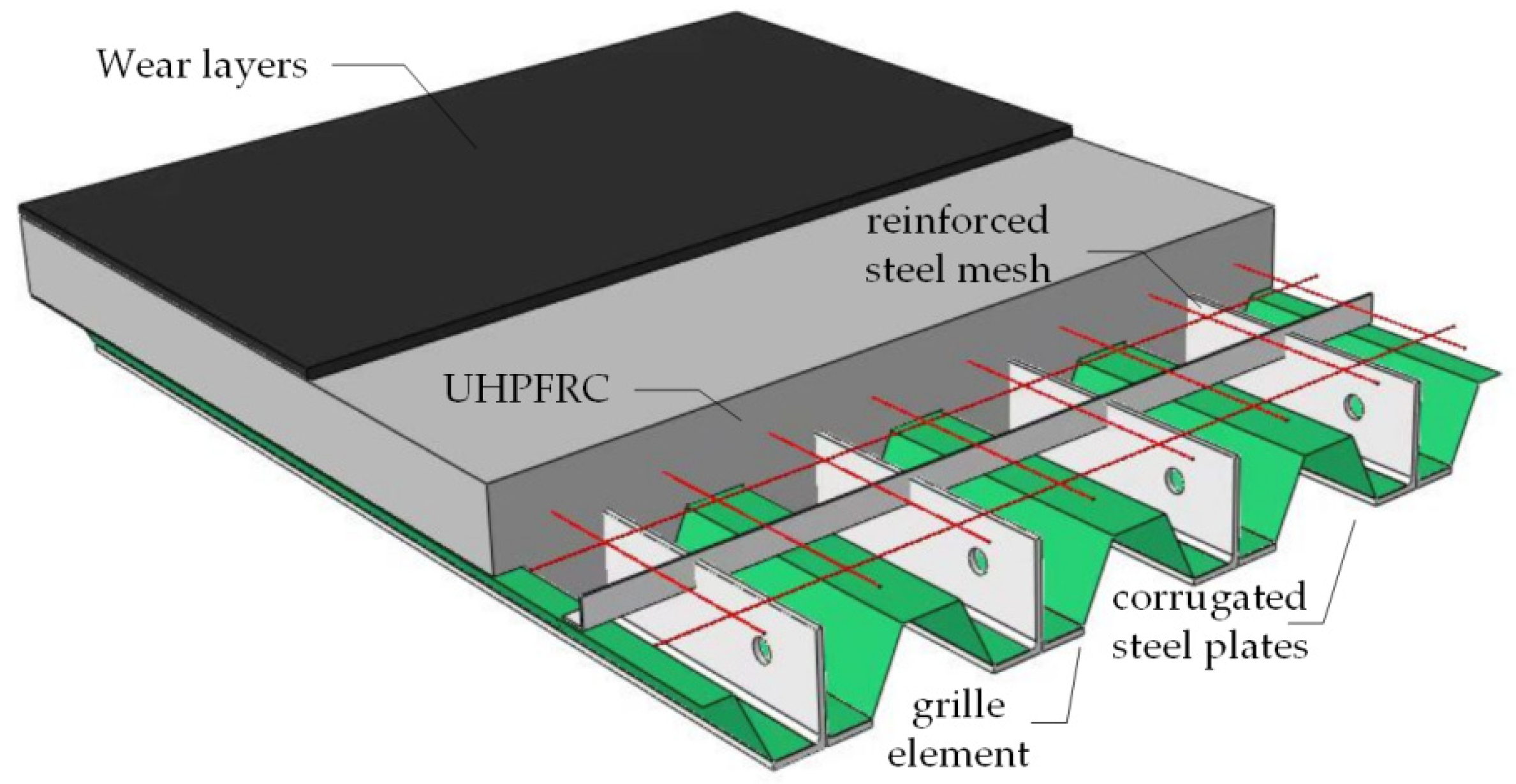

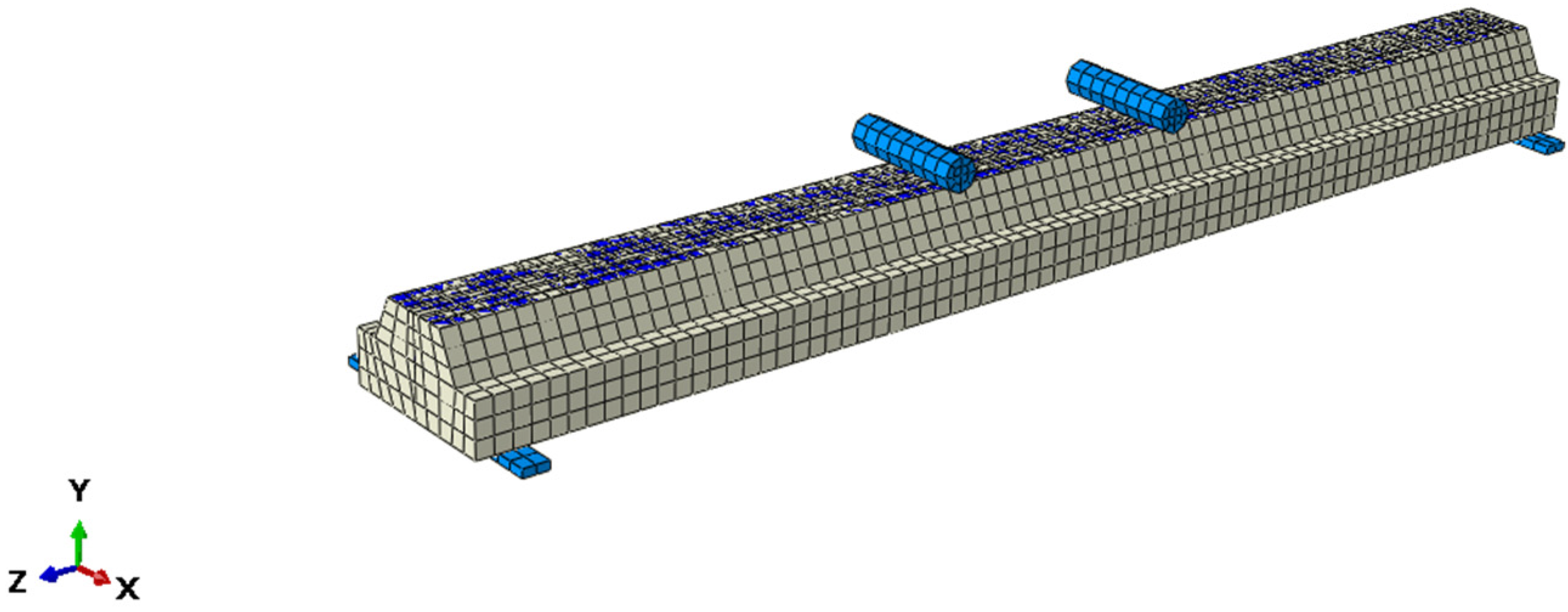
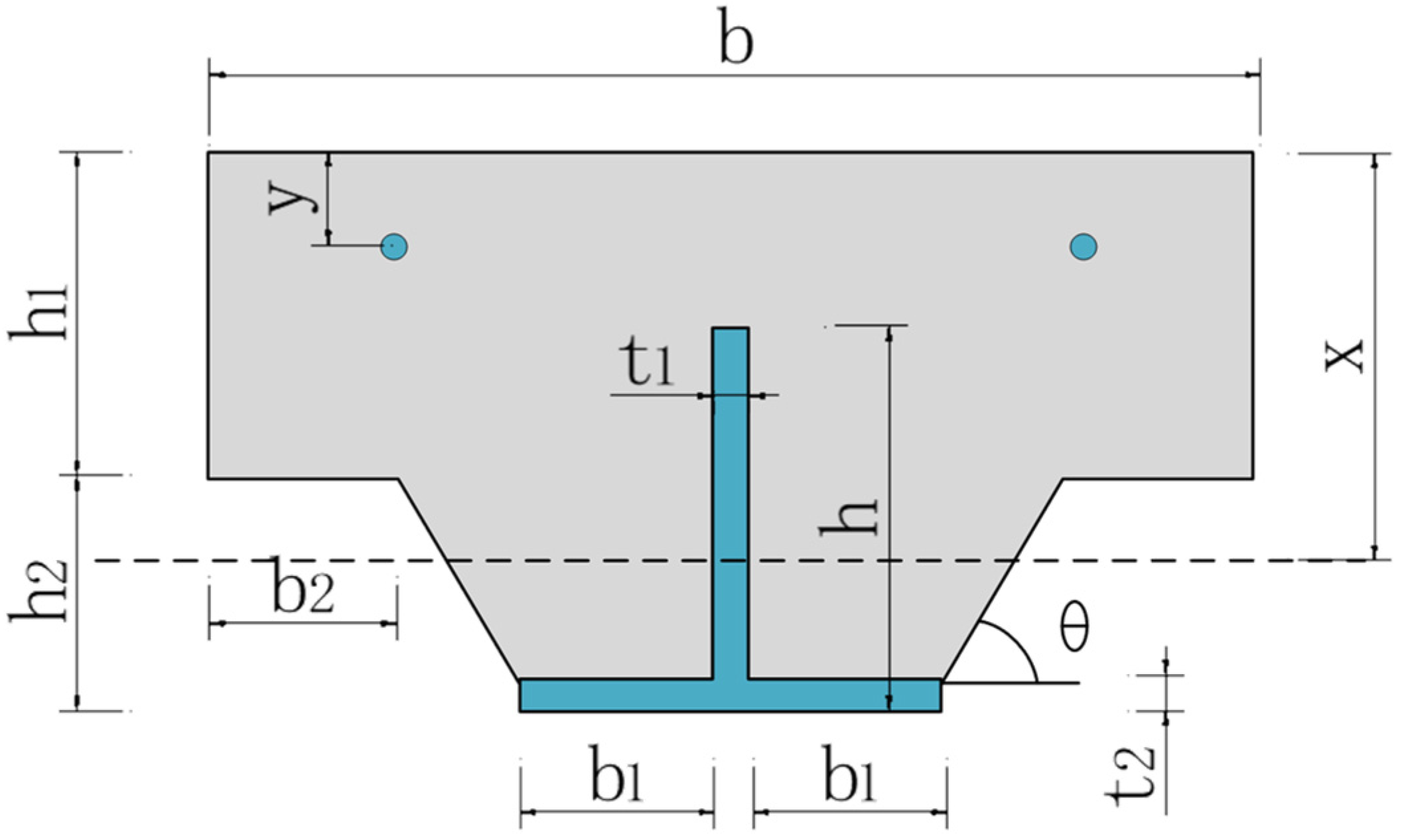
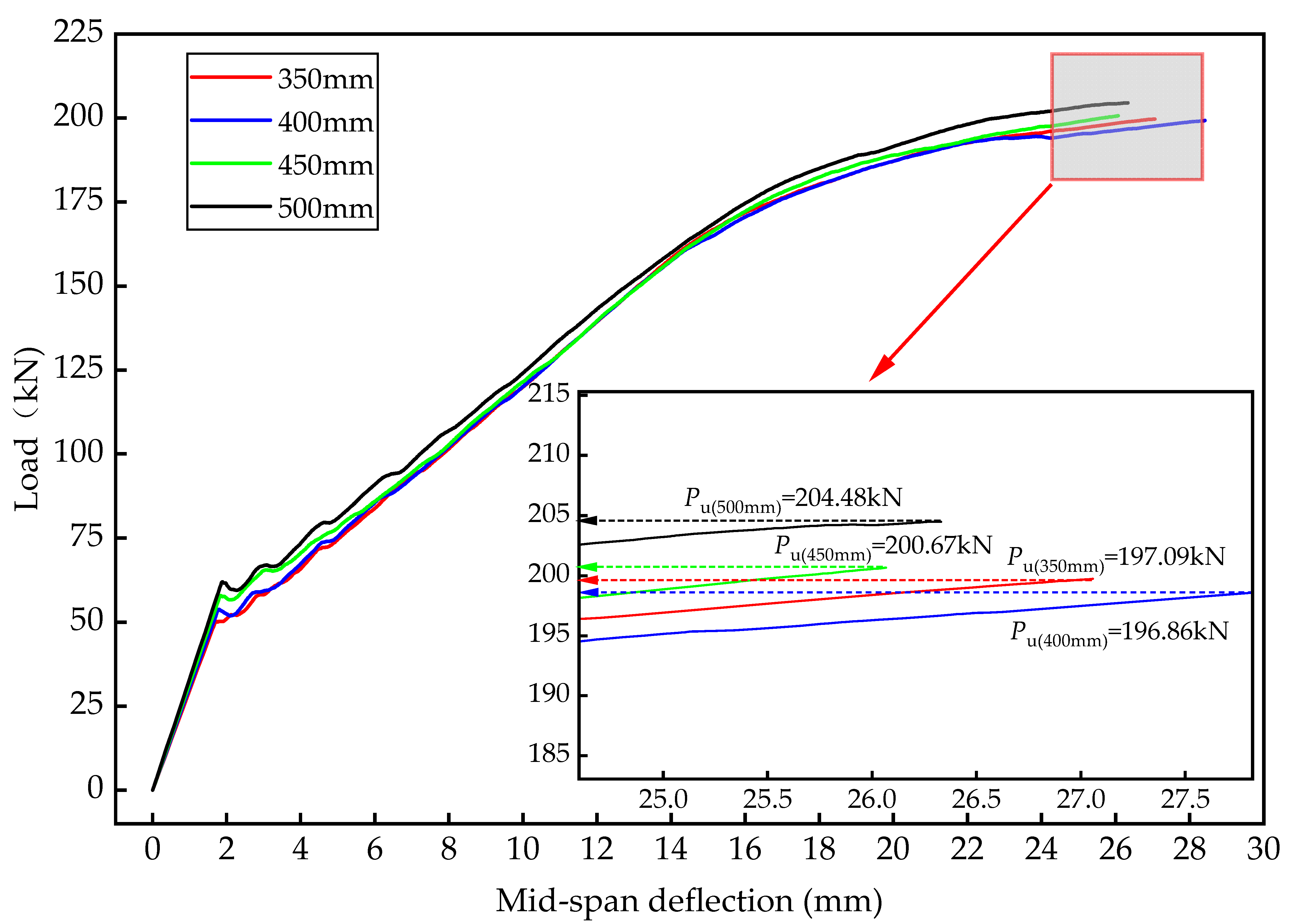
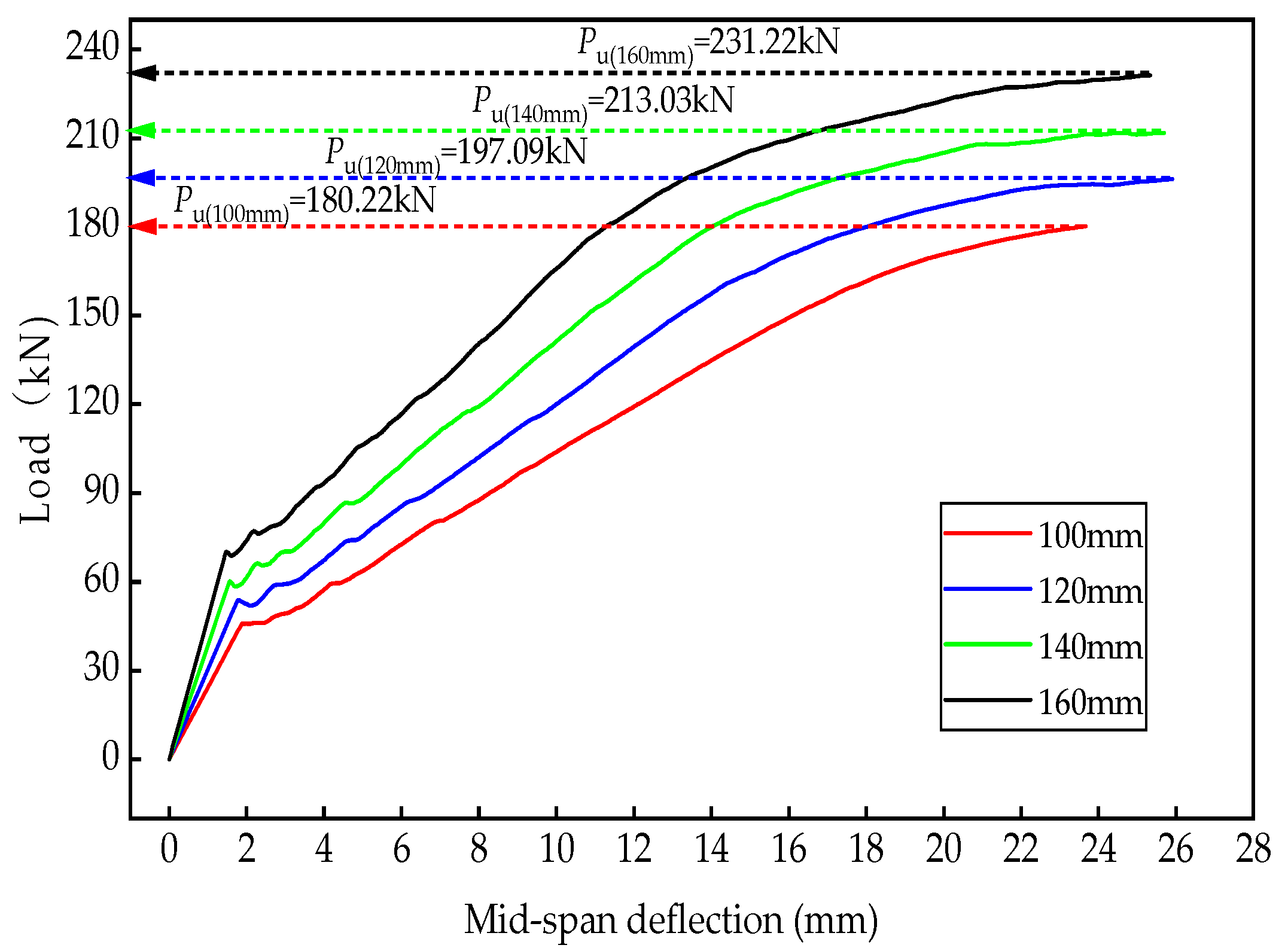
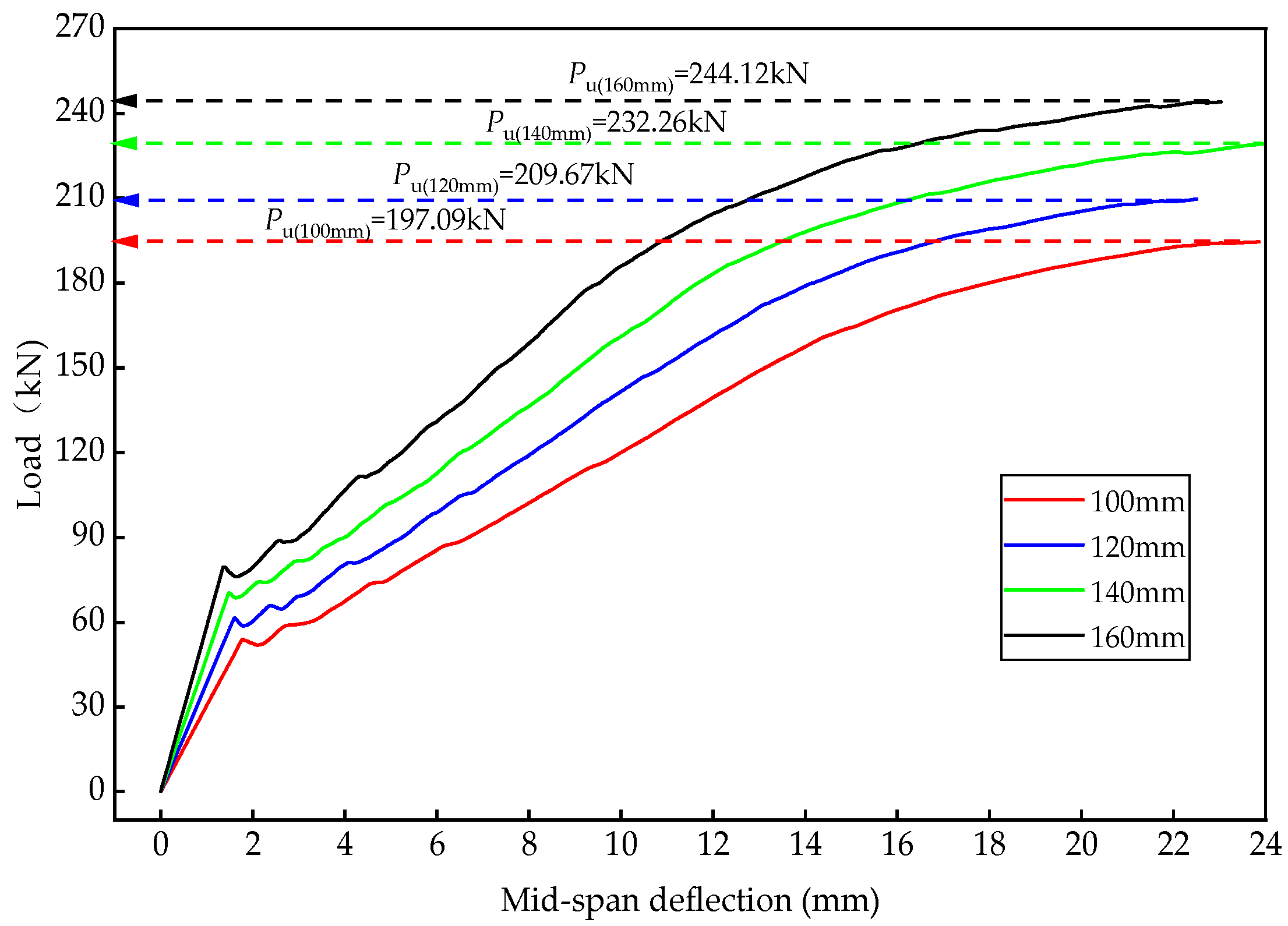
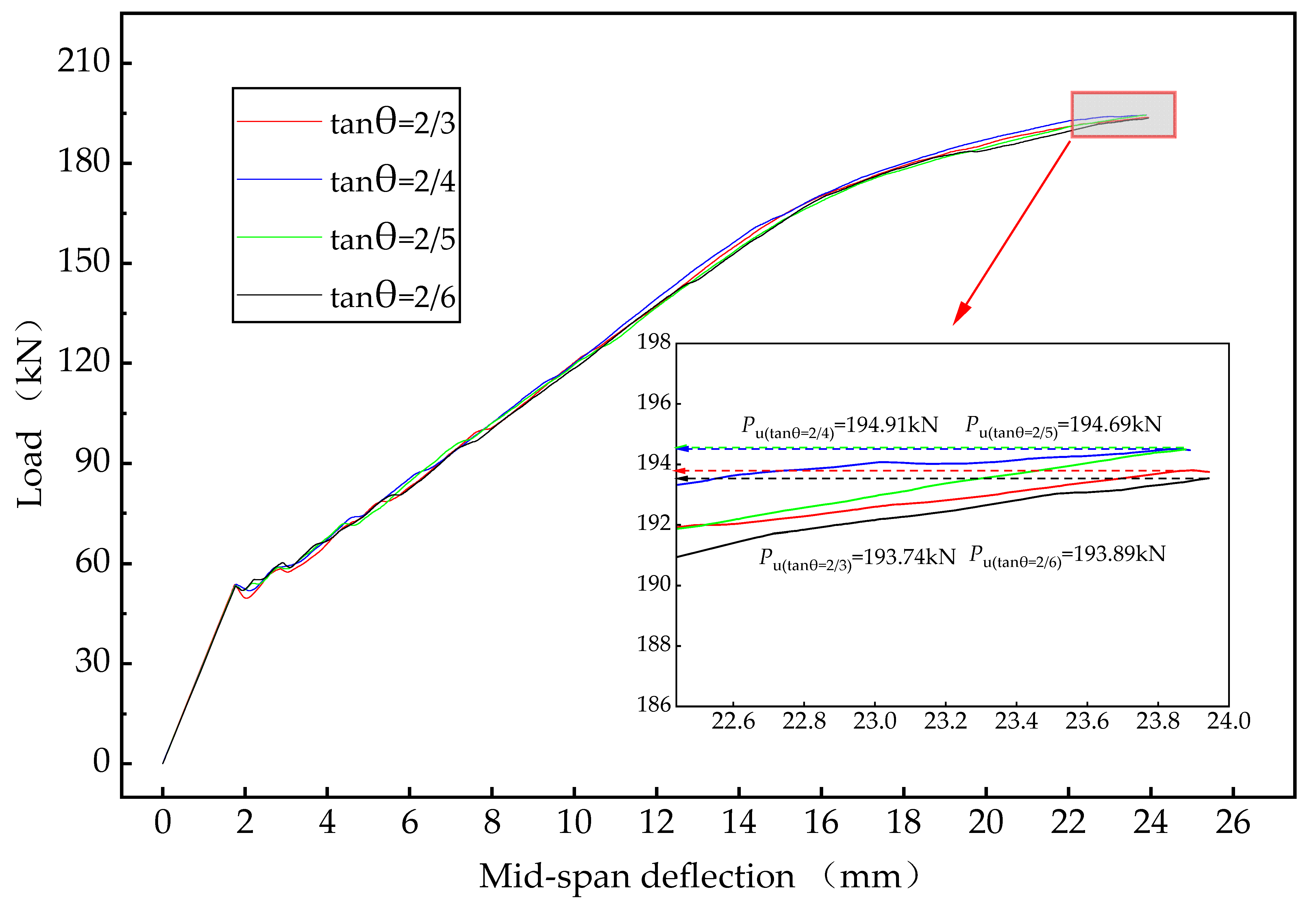
| Cement | Coal Ash | Sand | Crushed Stone | Steel Fiber | Polyacrylonitrile Fiber | Water | Water Reducing Agent | |
|---|---|---|---|---|---|---|---|---|
| 5 mm~10 mm | 10 mm~25 mm | |||||||
| 400 | 100 | 756 | 398 | 596 | 95 | 1.1 | 160 | 7.5 |
| Compressive Strength (MPa) | Flexural Strength (MPa) | 28d Axial Tensile Strength (MPa) | Modulus of Elasticity | ||
|---|---|---|---|---|---|
| 7 d | 28 d | 7 d | 28 d | 6.54 | 41,800 |
| 50.3 | 60.3 | 7.4 | 9.8 | ||
| Modulus of Elasticity | Yield Strength (MPa) | Ultimate Strength (MPa) |
|---|---|---|
| 206,000 | 345 | 630 |
| Concrete slab width (mm) | 350 | 400 | 450 | 500 |
| Ultimate load capacity (kN) | 196.86 | 197.09 | 200.67 | 204.48 |
| Self-weight (kg) | 161.25 | 176.25 | 191.25 | 206.25 |
| Load capacity per unit mass (kN/kg) | 1.22 | 1.12 | 1.05 | 0.99 |
| Concrete flange thickness (mm) | 100 | 120 | 140 | 160 |
| Bending bearing capacity (kN) | 180.22 | 197.09 | 213.03 | 231.22 |
| Self-weight (kg) | 156.25 | 176.25 | 196.25 | 216.25 |
| Bearing capacity per unit mass (kN/kg) | 1.15 | 1.12 | 1.08 | 1.07 |
| Web height (mm) | 100 | 120 | 140 | 160 |
| Bending bearing capacity (kN) | 197.09 | 209.67 | 232.26 | 244.12 |
| Self-weight (kg) | 176.25 | 190.5 | 205.75 | 222 |
| Load capacity per unit mass (kN/kg) | 1.12 | 1.10 | 1.13 | 1.10 |
| Structural Parameter | Theoretical Values | Numerical Values Pu/kN ③ | Relative Deviation (③ − ②)/③ | |
|---|---|---|---|---|
| Mu/kN·m ① | Pu/kN ② | |||
| b = 350 | 100.20 | 178.92 | 196.86 | 9.1% |
| b = 400 | 102.97 | 183.87 | 197.09 | 6.6% |
| b = 450 | 105.58 | 188.54 | 200.67 | 6.0% |
| b = 500 | 109.25 | 195.09 | 204.48 | 4.6% |
| h1 =100 | 92.26 | 164.75 | 180.22 | 8.6% |
| h1 =120 | 102.97 | 183.87 | 197.09 | 6.7% |
| h1 = 140 | 112.10 | 200.17 | 213.03 | 6.0% |
| h1 = 160 | 123.00 | 219.64 | 231.21 | 5.0% |
| h2 = 100 | 102.97 | 183.87 | 197.09 | 6.7% |
| h2 = 120 | 111.05 | 198.30 | 209.67 | 5.4% |
| h2 = 140 | 120.84 | 215.78 | 232.26 | 7.1% |
| h2 = 160 | 131.27 | 234.41 | 244.12 | 4.0% |
| tanθ = 2/3 | 103.17 | 184.24 | 194.14 | 5.1% |
| tanθ = 2/4 | 102.97 | 183.87 | 197.09 | 6.7% |
| tanθ = 2/5 | 102.64 | 183.29 | 196.91 | 6.9% |
| tanθ = 2/6 | 102.55 | 183.13 | 193.89 | 5.5% |
| Items | NSCBD ① | CSCBD ② | Ratio (①/②) |
|---|---|---|---|
| Mass (kg/m) | 246.22 | 197.09 | 1.25 |
| Cost ($/m) | 116.62 | 104.85 | 1.11 |
| Deflection (mm) | 4.04 | 7.77 | 0.52 |
| Bearing capacity (kN/kg) | 1.18 | 1.05 | 1.12 |
| Type | b (mm) | h1 (mm) | h2 (mm) | tan θ |
|---|---|---|---|---|
| NSCBD | 350 | 140 | 140 | 0.5 |
| CSCBD | 350 | 140 | 140 | 0.5 |
| Raw Material | Energy Consumption (MJ) | Greenhouse Gas Emissions (kg) | ||
|---|---|---|---|---|
| NSCBD | CSCBD | NSCBD | CSCBD | |
| Cement | 0 | 82,750 | 0 | 18,900 |
| steel bars | 0 | 234,688 | 0 | 29,301 |
| steel fibers | 0 | 96,800 | 0 | 7200 |
| shear connectors | 0 | 27,160 | 0 | 3409 |
| water reducing agents | 0 | 38,240 | 0 | 1709 |
| crushed stone materials | 113826 | 33,850 | 19,651 | 6799 |
| asphalt matrix | 2159738 | 346,820 | 77,661 | 12,017 |
| summary | 2273564 | 860,308 | 93,856 | 75,831 |
| Raw Material | Energy Consumption (MJ) | Greenhouse Gas Emissions (kg) | ||
|---|---|---|---|---|
| NSCBD | CSCBD | NSCBD | CSCBD | |
| Excavator | 103,517 | 58,993 | 33,491 | 18,527 |
| loader | 39,874 | 21,364 | 11,642 | 7126 |
| milling machine | 1285 | 93 | 432 | 26 |
| vacuum cleaner | 48,697 | 24,897 | 15,741 | 8324 |
| welding machine | 0 | 201 | 0 | 52 |
| concrete mixer | 0 | 2287 | 0 | 741 |
| EAC mixer | 73,561 | 21,369 | 22,647 | 6854 |
| plate vibrator, | 0 | 152 | 0 | 38 |
| high-temperature steam curing machine | 0 | 9187 | 0 | 2947 |
| grooving machine | 0 | 1057 | 0 | 407 |
| EAC paver | 61,254 | 39,564 | 19,620 | 12,647 |
| roller | 21,958 | 20,951 | 7457 | 9761 |
| summary | 350,146 | 200,115 | 111,030 | 67,450 |
Disclaimer/Publisher’s Note: The statements, opinions and data contained in all publications are solely those of the individual author(s) and contributor(s) and not of MDPI and/or the editor(s). MDPI and/or the editor(s) disclaim responsibility for any injury to people or property resulting from any ideas, methods, instructions or products referred to in the content. |
© 2024 by the authors. Licensee MDPI, Basel, Switzerland. This article is an open access article distributed under the terms and conditions of the Creative Commons Attribution (CC BY) license (https://creativecommons.org/licenses/by/4.0/).
Share and Cite
Ma, J.; Yuan, H.; Zhang, J.; Luo, Z. Numerical and Theoretical Study on Flexural Performance and Reasonable Structural Parameters of New Steel Grating–UHPFRC Composite Bridge Deck in Negative Moment Zone. Buildings 2024, 14, 2857. https://doi.org/10.3390/buildings14092857
Ma J, Yuan H, Zhang J, Luo Z. Numerical and Theoretical Study on Flexural Performance and Reasonable Structural Parameters of New Steel Grating–UHPFRC Composite Bridge Deck in Negative Moment Zone. Buildings. 2024; 14(9):2857. https://doi.org/10.3390/buildings14092857
Chicago/Turabian StyleMa, Jianyong, Haoyun Yuan, Jiahao Zhang, and Zuolong Luo. 2024. "Numerical and Theoretical Study on Flexural Performance and Reasonable Structural Parameters of New Steel Grating–UHPFRC Composite Bridge Deck in Negative Moment Zone" Buildings 14, no. 9: 2857. https://doi.org/10.3390/buildings14092857






